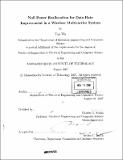Null power reallocation for data rate improvement in a wireless multicarrier system
Author(s)
Wu, Yun
DownloadFull printable version (13.01Mb)
Other Contributors
Massachusetts Institute of Technology. Dept. of Electrical Engineering and Computer Science.
Advisor
Charles G. Sodini.
Terms of use
Metadata
Show full item recordAbstract
Multicarrier systems are advantageous for high data rate transmissions in wireless environments due to their ease of implementation and tolerance for multipath delay spread. Currently, these systems as specified by the IEEE 802.11 standards do not adapt to frequency-selective fading but simply choose a constant data modulation scheme and transmit power level for all sub carriers in the available signal bandwidth. Although these implementations maintain acceptable performance when channel conditions are poor, they do not efficiently utilize the full capacity of a transmission channel. In the prototype system of the Wireless Gigabit Local Area Network (WiGLAN) project at MIT, a more efficient scheme is demonstrated where the modulation scheme of each subcarrier is selected individually based on the Signal-to-Noise ratio (SNR). To further improve the data rate of the WiGLAN system, this thesis describes the design of an adaptive transmit power allocation scheme that involves redistributing the power of "null" sub carriers with extremely low SNRs to the sub carriers that are utilized for data transmission. Experimental results demonstrate functionality of the simple redistribution scheme using the prototype transceiver nodes over various wireless channels, and show an average data rate improvement of 4.38% when the redistribution power is provided by 8 null sub carriers. Furthermore, a higher complexity waterfilling redistribution scheme is simulated and compared against the simple redistribution scheme. The simulations of the waterfilling scheme predict a higher data rate increase of 13.2% over no redistribution if given the same power availability of 8 null subcarriers.
Description
Thesis (M. Eng.)--Massachusetts Institute of Technology, Dept. of Electrical Engineering and Computer Science, February 2008. Includes bibliographical references (leaves 65-66).
Date issued
2008Department
Massachusetts Institute of Technology. Department of Electrical Engineering and Computer SciencePublisher
Massachusetts Institute of Technology
Keywords
Electrical Engineering and Computer Science.